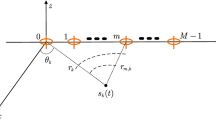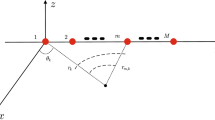Abstract
Many mixed near-field (NF) and far-field (FF) source localization algorithms in the open literature are developed based on the Fresnel approximation model, which is a simplified model of the exact source-array spatial geometry. Unlike these algorithms, in this paper, a new algorithm is derived to localize a mixture of NF and FF electromagnetic sources based on the exact spatial model with the use of a linear cocentered orthogonal loop and dipole (COLD) array. The summation of the dipole covariance matrix and the loop covariance matrix is shown to be independent of the source polarization parameters. Using this property, a multiple signal classification (MUSIC) pseudo-spectrum is defined for joint angle and range estimation. To facilitate the computational efficiency of the algorithm, a set of coarse angle and range estimates are derived using the estimating signal parameter via rotational invariance techniques (ESPRIT) philosophy to initiate the MUSIC searching. The major advantage of the proposed algorithm over the existing algorithms is that it does not introduce the systematic errors caused by the mismatch between the exact model and the Fresnel approximation model.




Similar content being viewed by others
Data Availability Statement
The data used to support the findings of this study are available from the corresponding author upon request.
References
H. Chen, W. Liu, W.-P. Zhu, M.N.S. Swamy, Q. Wang, Mixed rectilinear sources localization under unknown mutual coupling. J. Frankl. Inst. 356(4), 2372–2394 (2019)
J.P. Delmas, M.N.E. Korso, H. Gazzah, M. Castella, CRB analysis of planar antenna arrays for optimizing near-field source localization. Signal Process. 127, 117–134 (2016)
B. Friedlander, Localization of signals in the near-field of an antenna array. IEEE Trans. Signal Process. 67(15), 3885–3893 (2019)
J. He, M.N.S. Swamy, M.O. Ahmad, Efficient application of MUSIC algorithm under the coexistence of far-field and near-field sources. IEEE Trans. Signal Process. 60(4), 2066–2070 (2012)
J. He, L. Li, T. Shu, Near-field parameter estimation for polarized source using spatial amplitude ratio. IEEE Commun. Lett. 24(9), 1961–1965 (2020)
J. He, L. Li, T. Shu, Localization of near-field sources for exact source-sensor spatial geometry. IEEE Signal Process. Lett. 27, 1040–1044 (2020)
J. He, L. Li, T. Shu, T.-K. Truong, Mixed near-field and far-field source localization based on exact spatial propagation geometry. IEEE Trans. Veh. Technol. 70(4), 3540–3551 (2021)
Y. Hsu, K.T. Wong, L. Yeh, Mismatch of near-field bearing range spatial geometry in source-localization by a uniform linear array. IEEE Trans. Antennas Propag. 59(10), 3658–3667 (2011)
J. Jiang, F. Duan, J. Chen, Y. Li, X. Hua, Mixed near-field and far-field sources localization using the uniform linear sensor array. IEEE Sens. J. 13(8), 3136–3143 (2013)
J. Jiang, F. Duan, X. Wang, An efficient classification method of mixed sources. IEEE Sens. J. 16(10), 3731–3734 (2016)
D.H. Johnson, D.E. Dudgeon, Array Signal Processing: Concepts and Techniques (Prentice-Hall, Upper Saddle River, 1993)
H. Krim, M. Viberg, Two decades of array signal processing research: the parametric approach. IEEE Signal Process. Mag. 13(4), 67–94 (1996)
J. Li, P. Stoica, D. Zheng, Efficient direction and polarization estimation with a COLD array. IEEE Trans. Antennas Propag. 44(4), 539–547 (1996)
J. Liang, D. Liu, Passive localization of mixed near-field and far-field sources using two-stage MUSIC algorithm. IEEE Trans. Signal Process. 58(1), 108–120 (2010)
G. Liu, X. Sun, Efficient method of passive localization for mixed far-field and near-field sources. IEEE Antennas Wirel. Propag. Lett. 12, 902–905 (2013)
G. Liu, X. Sun, Two-stage matrix differencing algorithm for mixed far-field and near-field sources classification and localization. IEEE Sens. J. 14(6), 1957–1965 (2014)
G. Liu, X. Sun, Spatial differencing method for mixed far-field and near-field sources localization. IEEE Signal Process. Lett. 21(11), 1331–1335 (2014)
A.M. Molaei, B. Zakeri, S.M. Hosseini Andargoli, Components separation algorithm for localization and classification of mixed near-field and far-field sources in multipath propagation. IEEE Trans. Signal Process. 68, 404–419 (2020)
S. Pasupathy, W.J. Alford, Range and bearing estimation in passive sonar. IEEE Trans. Aerosp. Electron. Syst. 16(2), 244–249 (1980)
R. Roy, T. Kailath, ESPRIT-estimation of signal parameters via rotational invariance techniques. IEEE Trans. Acoust. Speech Signal Process. 37(7), 984–995 (1989)
R.O. Schmidt, Multiple emitter location and signal parameter estimation. IEEE Trans. Antennas Propag. 34(3), 276–280 (1986)
T. Shu, L. Li, J. He, Near-field localization for non-circular sources in the presence of sensor phase uncertainties. IEEE Wirel. Commun. Lett. 10(3), 562–566 (2021)
T. Shu, J. He, L. Li, Near-field passive localization and gain-phase compensation with partly calibrated arrays. IEEE Trans. Aerosp. Electron. Syst. (2021). https://doi.org/10.1109/TAES.2021.3098111
T. Shu, J. He, V. Dakulagi, 3-D near-field source localization using a spatially spread acoustic vector sensor. IEEE Trans. Aerosp. Electron. Syst. (2021). https://doi.org/10.1109/TAES.2021.3092703
H.L. Van Trees, Optimum Array Processing, Part IV of Detection, Estimation, and Modulation Theory (Wiley, New York, 2002)
L. Wan, K. Liu, Y.-C. Liang, T. Zhu, DOA and polarization estimation for non-circular signals in 3-D millimeter wave polarized massive MIMO systems. IEEE Trans. Wirel. Commun. 20(5), 3152–3167 (2021)
B. Wang, J. Liu, X. Sun, Mixed sources localization based on sparse signal reconstruction. IEEE Signal Process. Lett. 19(8), 487–490 (2012)
B. Wang, Y. Zhao, J. Liu, Mixed-order MUSIC algorithm for localization of far-field and near-field sources. IEEE Signal Process. Lett. 20(4), 311–314 (2013)
K. Wang, L. Wang, J. Shang, X. Qu, Mixed near-field and far-field source localization based on uniform linear array partition. IEEE Sens. J. 16(22), 8083–8090 (2016)
M. Wax, T. Kailath, Detection of signals by information theoretic criteria. IEEE Trans. Acoust. Speech Signal Process. 33(4), 387–392 (1985)
F. Wen, J. Shi, Z. Zhang, Closed-form estimation algorithm for EMVS-MIMO radar with arbitrary sensor geometry. Signal Process. 186, 108117 (2021)
G. Zheng, Y. Song, C. Chen, Height measurement with meter wave polarimetric MIMO radar: signal model and MUSIC-like algorithm. Signal Process. (2022). https://doi.org/10.1016/j.sigpro.2021.108344
Z. Zheng, M. Fu, D. Jiang, W. Wang, S. Zhang, Localization of mixed far-field and near-field sources via cumulant matrix reconstruction. IEEE Sens. J. 18(18), 7671–7680 (2018)
Z. Zheng, J. Sun, W. Wang, H. Yang, Classification and localization of mixed near-field and far-field sources using mixed-order statistics. Signal Process. 143, 134–139 (2018)
Z. Zheng, M. Fu, W. Wang, H.C. Ho, Mixed far-field and near-field source localization based on subarray cross-cumulant. Signal Process. 150, 51–56 (2018)
Z. Zheng, M. Fu, W. Wang, S. Zhang, Y. Liao, Localization of mixed near-field and far-field sources using symmetric double-nested arrays. IEEE Trans. Antennas Propag. 67(11), 7059–7070 (2019)
Z. Zheng, M. Fu, W. Wang, H.C. So, Symmetric displaced coprime array configurations for mixed near and far field source localization. IEEE Trans. Antennas Propag. 69(1), 465–477 (2021)
W. Zuo, J. Xin, N. Zheng, A. Sano, Subspace-based localization of far-Field and near-field signals without eigendecomposition. IEEE Trans. Signal Process. 66(17), 4461–4476 (2018)
W. Zuo, J. Xin, W. Liu, N. Zheng, H. Ohmori, A. Sano, Localization of near-field sources based on linear prediction and oblique projection operator. IEEE Trans. Signal Process. 67(2), 415–430 (2019)
Author information
Authors and Affiliations
Corresponding author
Additional information
Publisher's Note
Springer Nature remains neutral with regard to jurisdictional claims in published maps and institutional affiliations.
Rights and permissions
About this article
Cite this article
Yin, K., Dai, Y. & Gao, C. Mixed Near-Field and Far-field Source Localization Using COLD Arrays. Circuits Syst Signal Process 41, 3642–3655 (2022). https://doi.org/10.1007/s00034-021-01945-w
Received:
Revised:
Accepted:
Published:
Issue Date:
DOI: https://doi.org/10.1007/s00034-021-01945-w




